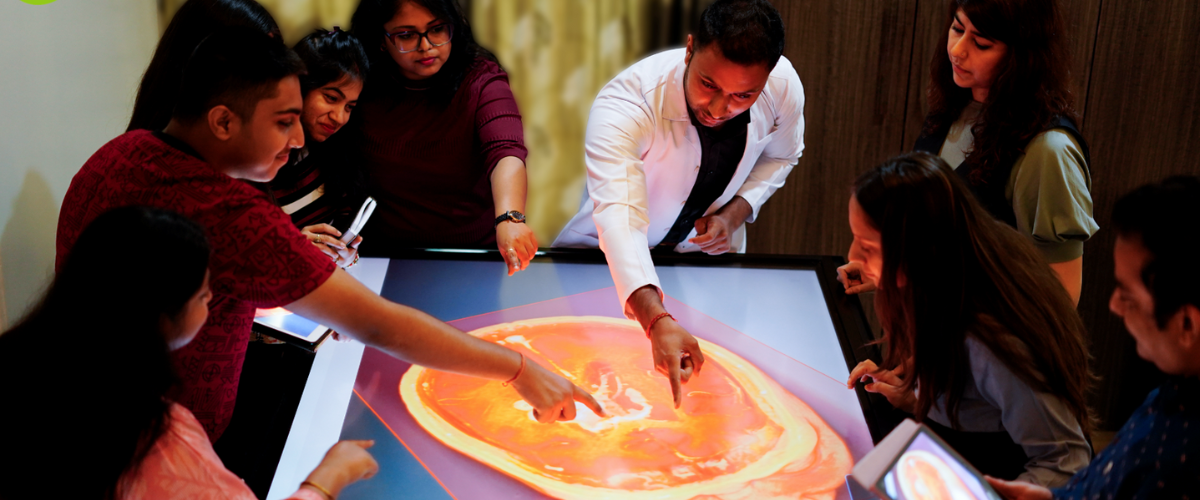The BodyViz Spaceship: Endless Exploration of Real Anatomy
April 26, 2023
%20(1).jpg)
Written By: Dr. Kenneth Elson
I am Dr. Kenneth Elson, but you will want to call me Dr. E. I am an active Diagnostic Radiologist, an instructor in Anatomy and Physiology at Roanoke College, an assistant professor of Anatomy at Virginia Tech Carilion Medical School, and a BodyViz Radiology consultant. However, my real position and passion is that of a student, a mentor, and a friend. I joke with my peers that I am the oldest student on campus and love when I get questions that I can’t answer.
The wonderful thing about teaching and studying anatomy is that you can NEVER learn it all. There is always something new to master and there is no such thing as normal anatomy or a stupid question. An example of the latter is a question that came up during our study of the Cranial Nerves. A student asked why we use Roman numerals, i.e., X for the Vagus nerve rather than just using the number 10. Well, that is an interesting question considering that many students today have never encountered Roman Numerals in their schooling. About once a month I have a light bulb moment and fortunately, it appeared at that second. It would have been demeaning to say to the inquisitive student that the Cranial nerves have always been roman numerals and will be forever, but instead I offered that if we were discussing Cranial nerves with students in China, they would understand that X denoted the Vagus nerve but 10 would mean nothing in their language. Whew, saved by an aberrant axonal connection! Aberrant brings up one of the many great features about BodyViz’s interactive anatomy software.
Take the Nutcracker Syndrome* example below, which BodyViz has in their dataset library. If you only learn the normal anatomy of the superior mesenteric artery, you miss a wonderful exploration of a rare and unusual variant that has real clinical implications. If the left renal vein is compressed between the aorta and the superior mesenteric artery, the result is a potential major body plumbing issue. The left renal vein dilates, the blood backs up into the left kidney and new vessels (called collaterals) develop. The latter may enlarge and form a pathway with the gonadal vein on the left which may then cause enlargement of the pelvic veins. This condition is seen predominantly in women and presents as pelvic pain from congested enlarged veins. Men may develop a left varicocele. The condition is also associated with blood in the urine (hematuria), back pain and sometimes death of the left kidney. In addition, the Nutcracker syndrome is associated with Wilkie’s Syndrome, a topic for another day or maybe your google assignment for the week!
*Nutcracker syndrome is a rare condition where the left renal vein (The vein that carries blood from the left kidney to the heart) is compressed or pinched between the abdominal aorta and the superior mesenteric artery.
 So, in a very short time you can learn the normal anatomy of the Superior Mesenteric Artery as well as its association with the renal vein, leading to a review of the anatomy of the gonadal vein, learning about a varicocele and pelvic vein congestion. Cool, right?
So, in a very short time you can learn the normal anatomy of the Superior Mesenteric Artery as well as its association with the renal vein, leading to a review of the anatomy of the gonadal vein, learning about a varicocele and pelvic vein congestion. Cool, right?
BodyViz 3D anatomy software enables you to follow the entire course of these vessels and learn an amazing amount of anatomy in very little time. Not long ago, this little anatomy lesson would have taken me a week to dig out of the literature. Not now. Amazing.
In the very old movie, Fantastic Voyage, a small spaceship was inserted into a human vein and the movie heroes and heroines cruised through the body’s anatomy fighting bacteria (really big on screen) and other maladies. Now imagine you are the heroes fighting off bacteria and BodyViz 3D anatomy software is your spaceship, allowing you to virtually dissect and explore real human anatomy in incredible detail. Well, that’s exactly what BodyViz enables you to do. With over 1,000 3D visualizations in the dataset library showcasing different examples of pathology and variants, the amount of anatomical information your students will walk away with is remarkable.
To learn more about BodyViz’s 3D virtual anatomy dissection platform and their dataset library containing over 1,000 MRI and CT scans, schedule a demo at a time that works best for you and follow the helpful links below.
Get started with virtual 3D anatomy
Schedule a Demo
Helpful Links: